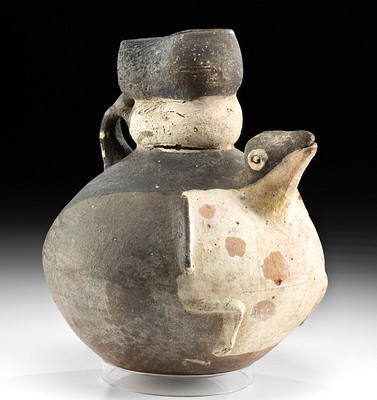19th C. Hawaiian Basalt Stone Poi Pounder
Lot 92
About Seller
Artemis Fine Arts
686 S Taylor Ave, Ste 106
Louisville, CO 80027
United States
Selling antiquities, ancient and ethnographic art online since 1993, Artemis Gallery specializes in Classical Antiquities (Egyptian, Greek, Roman, Near Eastern), Asian, Pre-Columbian, African / Tribal / Oceanographic art. Our extensive inventory includes pottery, stone, metal, wood, glass and textil...Read more
Estimate:
$1,600 - $2,400
Absentee vs Live bid
Two ways to bid:
- Leave a max absentee bid and the platform will bid on your behalf up to your maximum bid during the live auction.
- Bid live during the auction and your bids will be submitted real-time to the auctioneer.
Bid Increments
| Price | Bid Increment |
|---|---|
| $0 | $25 |
| $300 | $50 |
| $1,000 | $100 |
| $2,000 | $250 |
| $5,000 | $500 |
| $10,000 | $1,000 |
| $20,000 | $2,500 |
| $50,000 | $5,000 |
| $100,000 | $10,000 |
| $200,000 | $20,000 |
About Auction
By Artemis Fine Arts
Oct 28, 2021
Set Reminder
2021-10-28 12:00:00
2021-10-28 12:00:00
America/New_York
Bidsquare
Bidsquare : Fauna, Flora, Stone & Bones - Fall Edition
https://www.bidsquare.com/auctions/artemis-gallery/fauna-flora-stone-bones---fall-edition-7768
Join us for a very special early Fall auction featuring fabulous fossils, rocks, and minerals, plus art depicting flora and fauna from antiquity to present day. This is one sale you won't want to miss! Artemis Fine Arts info@artemisgallery.com
Join us for a very special early Fall auction featuring fabulous fossils, rocks, and minerals, plus art depicting flora and fauna from antiquity to present day. This is one sale you won't want to miss! Artemis Fine Arts info@artemisgallery.com
- Lot Description
North Pacific, Hawaiian Islands, Maui-Lahaina, ca. 19th century CE. A sizable poi or medicine pounder, hand-carved from basalt in mottled hues of gray. The fine implement displays a thick handle and a corseted neck to increase the gripping ability of the wielder. The hefty pounding surface is circular in form with a slightly convex face and gradually widens downwards from the slender neck. Pounders like this could be used for making poi - a starchy staple in Hawaiian cuisine - or for preparing medicinal substances. Size: 5.5" L x 4.5" Diameter (14 cm x 11.4 cm)
Poi pounders, alongside adzes, were the most important stone tools in Polynesia and the Hawaiian Islands. The pounders, known locally as a "Ke'a Tuki Popoi," are used for pounding cooked taro root into poi, a staple of the islander diet. Taro root was steamed in an earthen oven, peeled using shells, and placed onto a slab of wood to be pounded. The pounded results were blended with water into a highly nutritious paste. Traditional calabash bowls were used as containers to hold poi mixtures, and traveling royalty were accompanied by their own poi maker, with his or her own poi-making implements like this one.
Provenance: private Hawaii, USA collection, acquired 1995 to 2010
All items legal to buy/sell under U.S. Statute covering cultural patrimony Code 2600, CHAPTER 14, and are guaranteed to be as described or your money back.
A Certificate of Authenticity will accompany all winning bids.
PLEASE NOTE: Due to recent increases of shipments being seized by Australian & German customs (even for items with pre-UNESCO provenance), we will no longer ship most antiquities and ancient Chinese art to Australia & Germany. For categories of items that are acceptable to ship to Australia or Germany, please contact us directly or work with your local customs brokerage firm.
Display stands not described as included/custom in the item description are for photography purposes only and will not be included with the item upon shipping.
#168081Surface and use expected abrasions and chips. Loss along edge just above the pounding face. Otherwise intact with light mineral deposits within the naturally porous surface.Condition
- Shipping Info
-
All shipping is handled in-house for your convenience. Your invoice from Artemis Gallery will include shipping calculation instructions. If in doubt, please inquire BEFORE bidding for estimated shipping costs for individual items.
-
- Buyer's Premium



 EUR
EUR CAD
CAD AUD
AUD GBP
GBP MXN
MXN HKD
HKD CNY
CNY MYR
MYR SEK
SEK SGD
SGD CHF
CHF THB
THB












